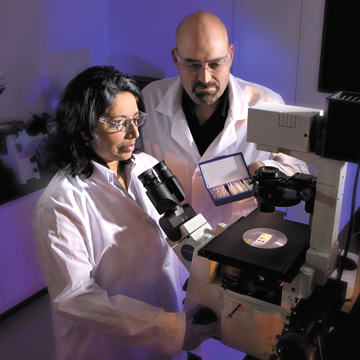
If a tree falls in the woods and no one is there to hear it, does it make a sound?
One of the more profound (or silly) questions of our time, yes, but Blake Simmons (8625) might rephrase the question as only a biochemist can: If a tree falls in the woods and no technology is in place to uncover the hidden sugars from within, will it deconstruct and produce clean-burning ethanol all on its own?
The answer, of course, is no, but the question drives home a larger point. “Trees,” says Blake, “don’t just fall apart at the whim of man. You have to do something to them to get them in the state that you want them to be.”
That ideal “state” — at least for biofuels researchers such as Blake and others working at the DOE’s Joint BioEnergy Institute (JBEI) in Emeryville, Calif. — would be one in which lignocellulosic biomass (such as trees, switchgrass, and other plants) could be efficiently and affordably processed in a way that will liberate the sugars needed to produce fuel.
There is a great need to improve the deconstruction of lignocellulosic biomass, says Glenn Kubiak, director of Sandia’s Biological and Materials Sciences Center 8600. “Why do we want to convert that biomass into a liquid form of energy?” asks Glenn. “The biomass itself already possesses a large amount of energy, available through combustion, so why invest a large R&D effort to transform, or deconstruct it, into fermentable saccharides?”
In answering those questions, Glenn points out the need to convert the biomass into a form of energy that burns more cleanly, and also to convert it to a portable, easily transported and stored liquid fuel, suitable for transportation applications.
Enter Seema Singh (8625), a Sandia biofuels researcher and lead author on a paper that currently appears in the online edition of Biotechnology and Bioengineering. Titled “Visualization of Biomass Solubilization and Cellulose Regeneration During Ionic Liquid Pretreatment of Switchgrass,” the article establishes JBEI’s footprint on the use of ionic liquid pretreatment technologies.
Breaking down cell walls
Ionic liquids are those that essentially contain only ions (atoms or molecules where the total number of electrons are unequal to the total number of protons, giving it a net positive or negative electrical charge). The many distinctive qualities of ionic liquids, which allow them to act as acids, bases, or ligands, make them ideal for use in organic chemistry, electrochemistry, catalysis, physical chemistry, and engineering.
The work reflected in the paper, Blake says, demonstrates that advanced imaging can successfully be used to understand the mechanisms of ionic liquid pretreatment. “Most important,” adds Seema, “it will enable further discoveries and improvements down the road as to how the first principles of this pretreatment technique work, and how the ionic liquid interacts with biomass.”
Current biomass pretreatment technologies, largely derived from the pulp and paper industry, involve dilute acid, ammonia fiber expansion, and hot water. All of the commercial entities involved in lignocellulosic biofuels (the noncorn, nonfood variety) are employing some variant of those technologies, says Blake, in an effort to break down the cell wall of the biomass plant, liberating the sugar-rich (and hence much sought-after) polysaccharides. Enzymes then are used to access the sugars, which are hydrolyzed into glucose and xylose — the feedstocks that go into the biofuel fermentation process.
The ionic liquid pretreatment process that Seema and her colleagues examined focused on its efficiency in processing switchgrass. According to a study by researchers at the University of Nebraska-Lincoln, switchgrass grown for biofuel production produced 540 percent more energy than needed to grow, harvest, and process it into cellulosic ethanol, making it a very attractive feedstock.
“The pretreatment process we looked at was remarkable in its ability to solubilize the plant cell wall,” says Seema. “Instead of increasing the surface of the cell wall or just realigning or readjusting it, the ionic liquid process completely transforms the plant cell wall into polymeric form.”
Floating in ionic liquid
Essentially, that means the three main elements of the biomass — the cellulose, hemicellulose, and lignin — are broken apart and floating in the ionic liquid, which makes those elements (once water or another antisolvent is added) much easier to access. The all-important polysaccharides can then be recovered.
This process, Seema says, demonstrates an exciting new method for converting polysaccharides into sugars in a way that is much more efficient in terms of both yield and time. Other researchers around the world are also examining ionic liquid pretreatment technologies, says Blake, but those efforts are primarily focused on processing microcrystalline cellulose derived from wood pulp. The JBEI research is the first to examine switchgrass and its interactions with ionic liquids to such an extensive degree, as well as the use of advanced imaging to help understand the mechanisms involved.
The Biotechnology and Bioengineering paper outlines the use of autofluorescence of the switchgrass cell wall to track the dissolution of ionic liquid pretreatment and the efficiency of that product to directly observe the fractionation between the polysaccharides and the lignin. This knowledge can now be used to inform a full computational modeling effort.
“This is the kind of thing that Sandia does particularly well,” says Blake. Essentially, he says, the research team created a new technique for interrogating something at very high resolution (plant biomass) interacting with something else (ionic liquids), and determining the nature and extent of that interaction, which in turn enables further discoveries based on that new knowledge.
Several other JBEI papers on biomass pretreatment are in development, addressing woody biomass, corn stover, and other agricultural residue. But as the first research project on this topic to come out of the JBEI effort, Blake and Seema are clearly proud of the work they’ve helped produce.
“This is the first significant step in biomass pretreatment for us and is indicative of what is sure to be an exciting, challenging, and productive period of scientific discovery by researchers at JBEI,” says Blake.